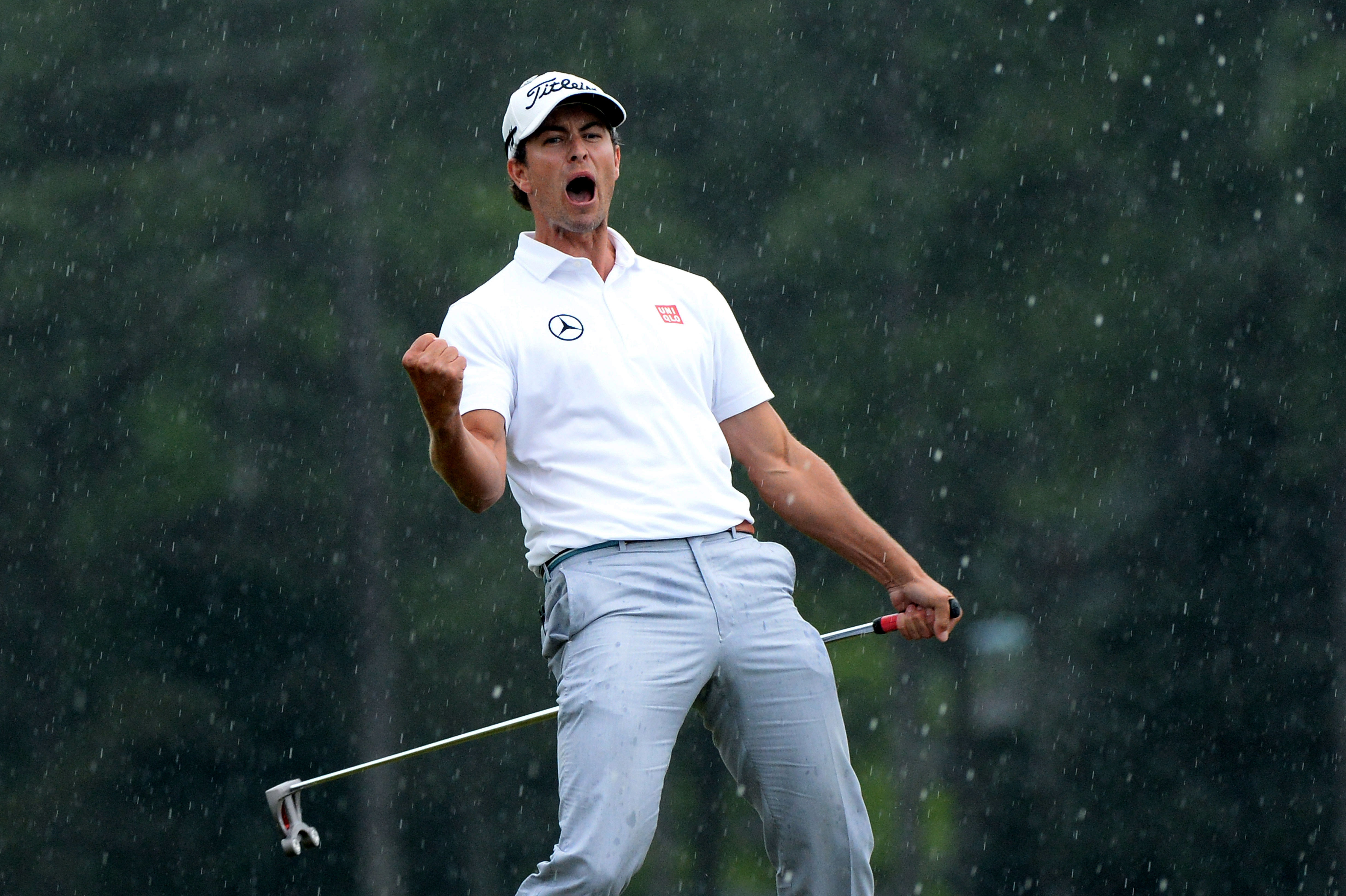Golf Instruction
Right-Hand Man: Using Your Right Hand More Effectively in the Golf Swing
The world’s best player, Scottie Scheffler, captured his sixth Tour title at TPC Sawgrass thanks to a five-shot margin of victory over runner-up finisher Tyrell Hatton.
For his efforts, Scottie cashed a cool 4.5 million-dollar check and added his name to the short list of players (Tiger, Jack) who’ve held both the Masters and Players Championship titles at the same time.
Parallel to this, Scottie’s short-and-long-game technique closely resembles the moves employed by the two greatest players of all time in Tiger and Jack. Specifically, all three men possess immaculate power and touch that rely largely upon the use of their dominant trail hand during the swing.
Around the green, they use their right hand more effectively by picking the club head up off the ground more abruptly in the backswing and thru greater use of the leading edge at impact. In the modern-teaching era, more instructors than ever before are teaching their students the downswing on full swings thru the use of distinctive “shallowing” moves, which are employed by several top players, including Collin Morikawa.
Collin’s shallowing move is made possible by utilizing more flexion in the left wrist during transition in order to deliver the club head into the back of the ball. Scottie, on the other hand, utilizes a far-more passive left hand during transition coupled with a more-active right hand that promotes a narrower angle of attack.
Rather than depending on their weaker lead hand for finesse, power, stability, and control, Scottie, Jack, and Tiger, all can be seen using more of their right hand in their own separate and unique ways.
The Golden Bear notoriously depended on his right hand for power and feel. To do so, Jack employed an interlocking grip in order to take his left-hand pointer finger off the grip of the golf club.
When he took the club back for full swings, he focused on keeping the clubhead low to the ground in a slow, well-timed manner in order to create a controlled, wide arc on the backswing. From there, he allowed his hands to elevate more so than Hogan and Nelson did, for instance, which meant he didn’t get as “deep” or behind his body as they would with his arms and hands at the top of the backswing.
Rather than relying on his core and his lead side for stability/power, Jack’s strong lower body allowed him to pick his left foot up off the ground during his backswing in order to get his dominant trailside in a more-optimal position to deliver the punch at impact. When the left heel came up, his left knee would move away from the target, and his hands would climb relatively high in relation to the ground at the top of his backswing.
If you love your dominant hand, take a page out of Jack’s book and get those hands high above your head/shoulders at the top of your backswing. Doing so makes it easier to keep the club head in front of your body throughout the swing while maintaining the width and arc to your backswing, which equate to power and consistency.
If you are struggling getting the ball airborne, high hands in the backswing in relation to the ground, shoulders, and head will get your ball up in the air very quickly and effectively. Don’t be afraid to lift your lead heel off the ground during the backswing if you’re able to stay on balance throughout your golf swing.
Doing so makes it easier to transfer your weight into your trailside on the backswing while also enabling you to push off the ground with your trail leg on the downswing in order to create more speed and power at impact. Also, getting your hands higher and less around on the backswing often allows for a more instinctual, athletic swing to run its course as opposed to consciously trying to get “deep” with your arms/hands while also not over-extending the lead arm.
In the age of biomechanics and big muscle training, golf instruction has curiously moved away from focusing on the smaller muscles in our arms and hands. Why? Because inadequate body movement can increase the potential for injury in the long term and, as such, isn’t ideal when building a sustainable golf swing according to the guiding principles of biomechanics.
In the age of consistency and sustainability, golfers are bulking up more and becoming more robotic or machine-like with their approach to the golf swing. While this methodical, structured approach has paid its dividends for some of the best players in the world, your average amateur golfer doesn’t have time to hit the gym like some of these monsters on Tour today who rely heavily on their big muscles for power and control.
Also, your average golfer over the entire course of his/her golfing career isn’t as susceptible to swing-related injuries when compared to the potential for injury that exists among professional golfers over their respective careers. Therefore, it’s okay to rely on your hands a bit more than what SuperStroke may contend is advisable.
While I’d love to have the core strength of a Brooks Koepka or a Dustin Johnson, it’s not a realistic proposition from a number of standpoints. At least not in this lifetime.
Similar to how Scottie drags his right foot on the downswing, a young Tiger Woods also utilized a trail foot slide in transition. If you watch Tiger swing the club during his early days on tour and when he was winning US Amateur’s, his right foot slides along the ground in transition and thru impact before he arrives at a balanced finish.
Like Scottie and Jack, Tiger loves his right hand/leg and routinely opts to get that dominant side in position to deliver the hit at impact. At the 1997 Masters, Tiger fired that right hand while dragging that right foot on the downswing and thru impact, much like Scheffler does today when he delivers the club into the slot.
Like Jack and Scottie, Tiger used the interlocking grip and swung the club in a more upright, steeper fashion on the backswing in order to deliver the blow with the right hand at impact. In Tiger’s book, “How I Play Golf,” he refers to himself as a “right-hand man” while employing a golf swing that directly promotes greater use of his more-dominant trail hand.
If you favor using one hand considerably more than the other, do not be afraid to trust it. When you really think about it, you’ve probably been using your dominant hand for innumerable purposes outside of golf over the course of your entire life.
In fact, there’s a strong possibility that your dominant hand/side has been running the show in many facets of your life prior to you even picking up a golf club for the first time. As such, these inherent habits/tendencies will express themselves during the natural course of the golf swing thru greater usage of the dominant side compared to that of the weaker lead side.
For golfers insisting on keeping their feet firmly planted in the ground while hitting balls with towels under both arms in order to “stay connected,” this is encouraged as long as it works for them. If you dance like Jack, Tiger, or Scottie during the swing, that works too! At the end of the day, perhaps the most important aspect of the body’s movement(s) as it relates to building the foundation for a consistent, reliable golf swing lies in having the ability to stay on balance.
If you can hold a full finish after hitting the center of the clubface with an optimal amount of clubhead speed, you can be a great golfer. While traditionalists like Nick Faldo may continue to express their own displeasure reacting to Scottie’s move, they also recognize its undeniably unique effectiveness. In other words, Scottie’s move clearly works for him.
If you like one hand/side of your body more than the other, go ahead and use it more. Once you’ve got it down, trust it. Belief goes a long way in this game.
Cover Image via Twitter
-

 News1 day ago
News1 day agoPolice release Scottie Scheffler’s Mugshot
-

 News4 days ago
News4 days agoRory McIlroy Files for Divorce from Erica Stoll
-

 News1 day ago
News1 day agoScottie Scheffler DETAINED by Police Outside of PGA Championship
-

 News24 hours ago
News24 hours agoHow Scottie Scheffler Can Miss His Tee Time and Still Play the PGA Championship
-

 News1 week ago
News1 week agoLIV Golf Has Tiger Woods and Rory McIlroy’s Relationship on Thin Ice
-

 Equipment1 week ago
Equipment1 week agoTitleist Hops On ‘Mini-Driver’ Hype with CRAZY TSR 2-Wood
-

 Fantasy Golf Predictions5 days ago
Fantasy Golf Predictions5 days agoFantasy Golf Picks, Odds, and Predictions – 2024 PGA Championship
-

 News4 days ago
News4 days agoAdam Scott Drops BOMBSHELL Regarding PGA Tour Board, Rory McIlroy Drama








